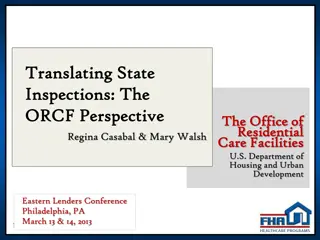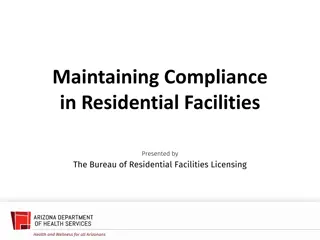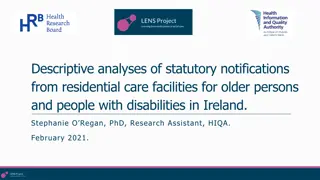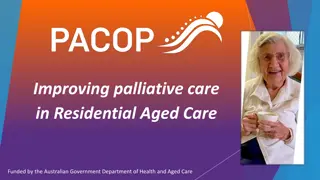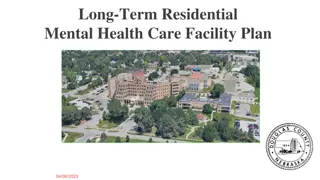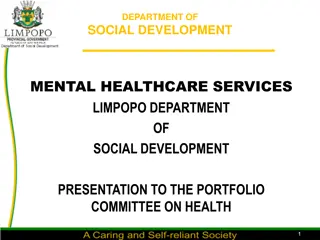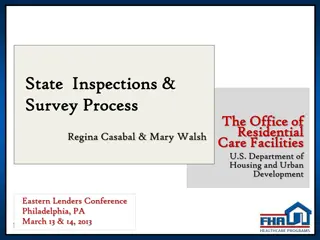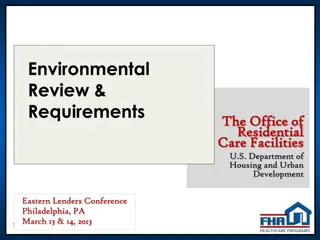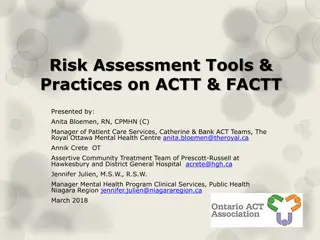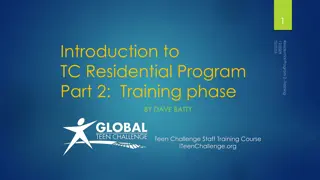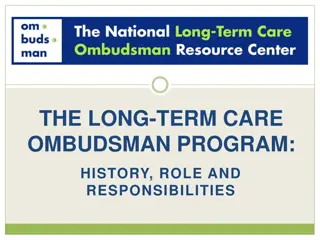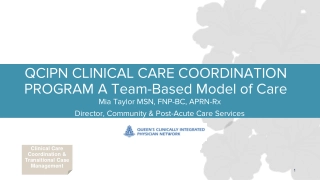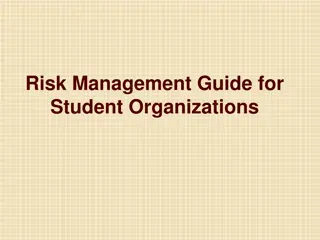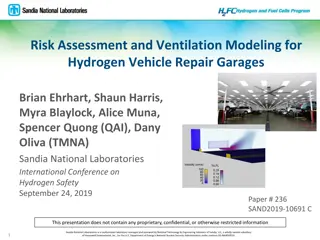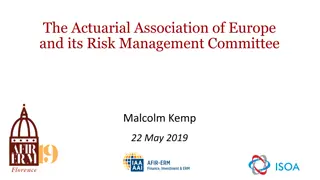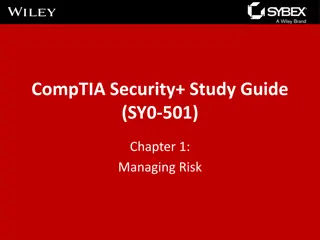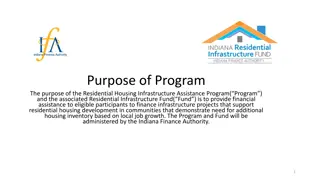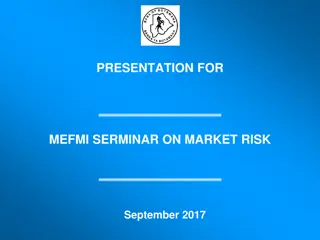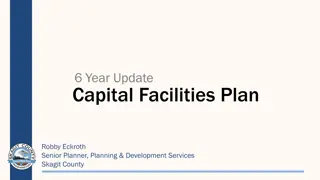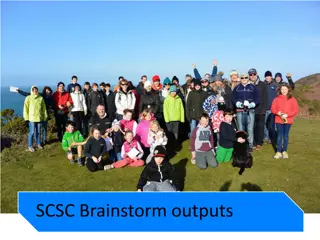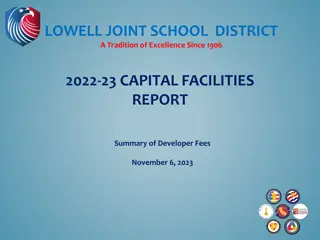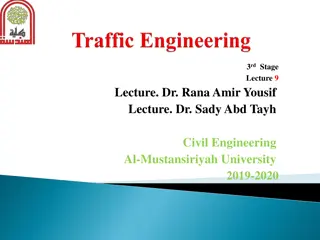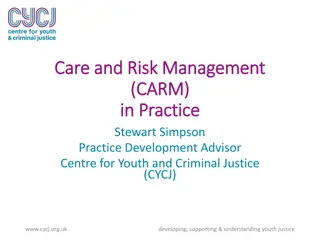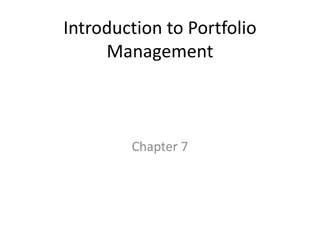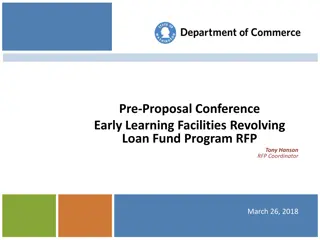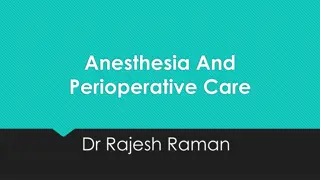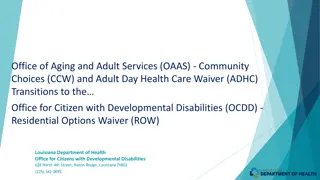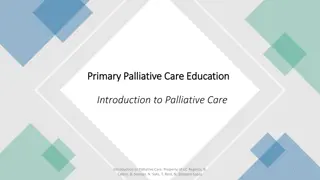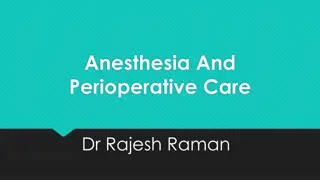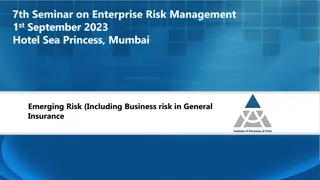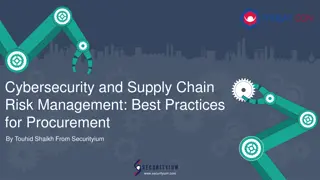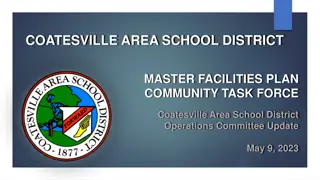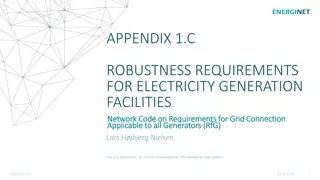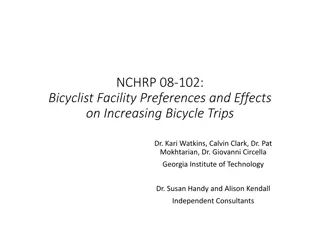Comprehensive Risk Management Program for Residential Care Facilities
Implementing a robust risk management program is crucial for residential care facilities to control risks related to personal injury and other damages. The program should include incident reporting, tracking systems, staff training, and collaboration with experienced professionals and third-party providers for effective risk prevention initiatives.
- Risk Management
- Residential Care Facilities
- Incident Reporting
- Staff Training
- Program Implementation
Download Presentation

Please find below an Image/Link to download the presentation.
The content on the website is provided AS IS for your information and personal use only. It may not be sold, licensed, or shared on other websites without obtaining consent from the author. Download presentation by click this link. If you encounter any issues during the download, it is possible that the publisher has removed the file from their server.
E N D
Presentation Transcript
Risk Management Risk Management Plans Plans The Office of The Office of Residential Residential Care Facilities Care Facilities U.S. Department of Housing and Urban Development Eastern Lenders Conference Philadelphia, PA March 13 & 14, 2013 1
INTRODUCTION PANEL MEMBERS JENNIFER BUHLMAN, ORCF MODERATOR KEITH PARNELL HAMILTON INSURANCE 2
Risk Management Requirement New Operator Regulatory Agreement In accordance with Program Obligations, Operator shall implement and maintain a risk management program which incorporates a real-time incident reporting and tracking system that informs Operator s senior management of all incidents with the potential to expose the Operator to liability for personal injury or other damages. Each incident must be reviewed by Operator s appropriately-trained professional staff, and such staff must follow-up on incidents as necessary. The risk management program must include appropriate training for Operator s staff. 3
Risk Management Requirement RATIONALE Assurance that the management team is taking steps to control risk every day Experienced professionals administering risk management program 4
Risk Management Requirement December 19, 2012 Email Blast Develop and document a comprehensive software- based risk management program and have designated staff positions to implement the risk management program Highly experienced long-term care risk manager develops the company s risk management program, tracks incidents, analyzes incident trends, trains/re-trains front line staff as needed, works with the professional liability insurance carrier, etc. 5
Risk Management Requirement December 19, 2012 Email Blast Contract with a third party provider of electronic risk management The statement of work must include, at a minimum, the following: Access and use of an electronic incident tracking and reporting system Facility incident reporting and tracking with the third party provider s data processing/risk management center Clinical specialists to review all incidents and trends and train staff accordingly Assist the facility in developing, implementing and maintaining appropriate risk prevention initiatives Third party provider must have years experience and client list 6
Risk Management Requirement Reviewed and approved by HUD prior to closing Maintain for the life of the loan Future requests for changes must be reviewed and approved by HUD Asset Management 7
Risk Management Expert Panel 8
Objectives Review definition of QAPI New expectations of QAPI Discuss the Five Elements Review the importance of collecting valid data to identify and monitor an effective Performance Improvement Project (PIP) Identify resources outlining a QAPI program 9
What is QAPI? Quality Assurance and Performance Improvement (QAPI) is a data-driven and pro- active approach to quality improvement. Collaborative commitment from all departments within a facility to continuously identify opportunities for improvement in the quality of care through a systemic approach 10
What is expected from QAPI? Quality Assurance and Performance Improvement The wheels are in motion for nursing homes to develop an effective Quality Assurance Performance Improvement (QAPI) program. Although Quality Assurance is not a new concept in long term care, there are some new components that nursing homes must include in their individualized QAPI program that can seem to be overwhelming. Owner/Board & executive leadership is expected to be committed to provide resources specifically dedicated to QAPI which includes training On-going, comprehensive program 11
Five Elements of QAPI Design & Scope Systemic Analysis & Systemic Action Governance & Leadership Feedback, Data System & Monitoring Performance Improvement Projects 12
Design & Scope A QAPI program must be ongoing and comprehensive Inclusive of all departments & functions Plan must address quality of care, quality of life, safety, and care transitions. Emphasizes & respects resident autonomy and choice in daily life activities 13
Element 1: Design & Scope Requirements Must be ongoing and comprehensive Include the full range of services offered by the facility and departments. Program should address clinical care, quality of life, resident choice, and care transitions. Utilize the best available evidence to define and measure goals. Source: CMS 14
Element 2: Governance & Leadership Expectations QAPI program must be spear-headed by the owners/board & executive leadership Work in tangent with facility staff and residents and/or their families Provide sufficient resources to conduct program, which includes designating one or more persons to be accountable for QAPI; developing leadership and facility-wide training on QAPI; and ensuring staff time, equipment, and technical training as needed for QAPI. Establish policies to sustain the QAPI program despite changes in personnel and turnover. Set priorities for the QAPI program and build on the principles identified in the design and scope. Set expectations around safety, quality, rights, choice, and respect. Support an atmosphere in which staff are not punished for errors and do not fear retaliation for reporting quality concerns while maintaining accountability Source: CMS 15
Element 3: Feedback, Data Systems, & Monitoring Feedback systems must monitor care & services from multiple sources including input from staff, residents, families, and others as appropriate. Utilize performance indicators to monitor a wide range of care processes and outcomes, and review findings against benchmarks and/or targets Track, investigate, and monitor all Adverse Events that occur, and develop action plans to prevent recurrences Source: CMS 16
Element 4: Performance Improvement Projects Conduct Performance Improvement Projects (PIPs) to examine and improve care or services in areas that are identified as needing attention. Performance Improvement Projects (PIPs) are high risk, high volume, problem-prone areas not necessarily clinical Source: CMS 17
Element 5: Systematic Analysis and Systemic Action Systematic approach to determine when in-depth analysis is needed to fully understand the problem, its causes, and implications of a change. Systemic Action in order to look comprehensively across all involved systems to prevent future events and promote sustained improvement. Focus is on continual learning and continuous improvement Source: CMS 18
The Incident Reporting Solution Benefits of capturing data electronically Summary Report by Facility/Region/State Incident Type/Severity Level Shift Location of incident Outcome Action Taken Provides Objective, unbiased data Early problem detection Trending and Educational Support 191 9
The Incident Reporting Solution Reliable data to develop PIPs & monitor systems Provides reliable and objective data to help identify Performance Improvement Projects (PIPs) and to perform systemic analysis. Data Systems, Systemic Analysis, & Monitoring Five recognized key Indicators: Falls Fractures Pressure Wounds Pain Medication Errors Improved reporting Capabilities Corrective action plans Benchmarking Monitoring systems implemented utilizing data 10% Reduction in Falls per 100 Beds Identifies high risk, high volume, problem areas Improved quality of care and environment for nursing home residents 20
The Incident Reporting Solution Key Business Elements Proven web-based health information technology with 12+ years of market experience 30+ companies with over 520 facilities nationwide Tool already in use at the Federal level (Dept. of Housing and Urban Development s (HUD) 232 program (Mortgage Insurance for Nursing Homes) Over half a million incidents (and growing) tracked and stored within the database enabling a significant reduction in falls and sever injuries Over 5,000 incidents tracked on a weekly basis Resulting in significant cost savings to the Medicare and Medicaid programs 21
The ERMA Solution Industry Impact Actions and Results ERMA implemented in 2006 Reporting / information used to dramatically improve risk program ERMA resulted in gains in better management and oversight of significant events early intervention increased quality of care and reduced cost Estimated savings $12,600,000 excluding litigation costs 22
Conclusion Federal Government invested in improving quality of patient care and cost saving with the LTC environment Potential to fundamentally improve and enrich the current type of quality reporting In conjunction with the QAPI process, Electronic Incident Reporting improves patient care and reduces Medicare/Medicaid costs 23



